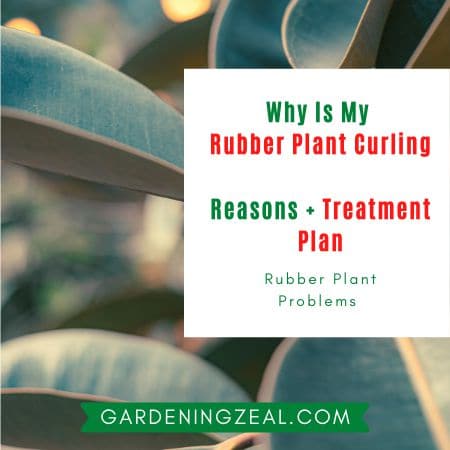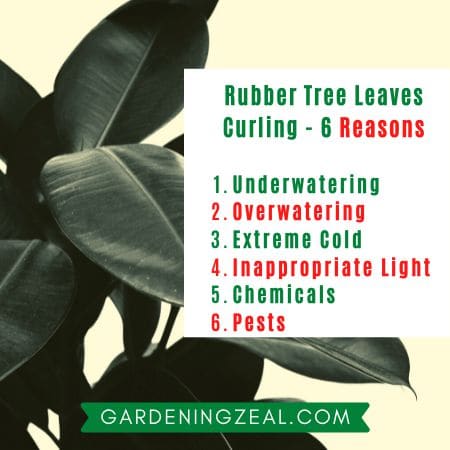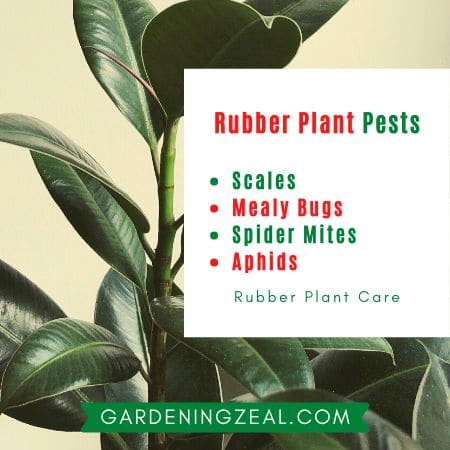Rubber trees (Ficus elastica) are tough yet easy to grow plants with deep-green, thick, and glossy leaves. Hence, it can be quite concerning when you find those shiny rubber tree leaves curling.
There are several problems that can lead to rubber plant leaves curling, such as inadequate water supply, cold weather, harsh sunlight, bug infestation, and the use of unsuitable insecticides. Provide your ficus plant with adequate water, sunlight, heat, and fertilizer to maintain healthy leaves.
Based on the way your rubber tree leaves have started to curl and your gardening habits, you can diagnose and treat any problem your plant might be facing.
Keep on reading to learn how to stop ficus tree leaves curling up.
Key Learning Points
Rubber Tree Leaves Curling – It Can Be Natural!
Before you worry and try all sorts of remedies to stop your ficus leaves from curling, check if the curled leaves are new growth. In a rubber tree, new leaf curling is a natural process. These leaves eventually uncurl and straighten out into large and attractive shiny leaves.

If your plant is forming new foliage, especially in spring, and only newer leaves are curling, sit back and relax, and maybe even pat yourself on the back to treat your plant well enough to grow new robust leaves.
Additionally, old leaves may also crumple up a bit and curl in different directions while turning yellow, which is part of their natural aging process.
However, if you notice several leaves, especially younger ones curling up, it’s a definite cause for concern.
6 Reasons Behind Rubber Plant Leaves Curling + Their Solution
Underwatering
When leaves become dehydrated due to underwatering, they start to curl downwards. Leaving your rubber plant’s soil dry for too long can cause dehydration as the roots won’t have any moisture left to supply to the leaves.
Rubber plants seldom get dehydrated, though, and they can remain healthy for weeks without watering. However, this changes if you live in a hot climate or an especially dry region.
Dehydration can be a cause of curled-up leaves in summers if you don’t water your plant at least once a week.
A good trick to check how much water your plant needs is by sticking your finger in the soil directly. If your finger comes out dry with sand-like soil, your plant is craving water.
How to Treat It:
As for the solution, simply water your plant regularly and keep it in a slightly more humid space. If the air is especially dry and arid, group your rubber tree with other humidity-loving plants and spray with a water-Neem oil mixture every few days.
Placing your plant in a humid area like the kitchen is an excellent idea as well. Using humidifier is also a wise solution to deal the problem.
But remember not to overwater trying to compensate for the pre-existing loss of moisture- which brings us to the next probable cause.

Overwatering
Overwatering is a common habit among new gardeners and hobbyists- and it’s the primary cause of plant disease. Whether it’s curling of leaves at their base, rotting of roots, or mold growth, overwatering is the main criminal.
Underwatering is better than overwatering in most instances because extra water can lead to root rot, which is significantly harder to reverse than replenishing dry roots.
Check the roots if you find your Ficus elastica leaves curling upwards (or downwards near the stem). If they’re drenched and starting to rot, then it’s a case of overwatering.
How to Treat It:
Immediately take action- stop watering and arrange sufficient drainage space at the bottom of the pot. Only water your plant once the top bit of the soil is dry for about an inch, which is roughly every 5-6 days. Don’t give the plant too much water at once either.
Cold Weather
Ficus elastica thrives in warm temperatures. Cold weather, especially near the freezing point, can put great strain on the plant, curling its leaves and stunting its growth.
Leaves often curl upwards and inwards when they’re stressed out by the cold. In addition to cold weather, rapidly shifting temperatures can also cause curling.
How to Treat It:
To prevent this curling response, maintain a temperature between 12°C-30°C (55°F-85°F) where your rubber plant is kept.
If you keep the plant outside, make sure to bring it inside before frost season begins, and temperatures drop. Avoid switching the plant between different rooms or from outdoors to indoors frequently.
Keep the plant near a window instead of taking it outside for some sun. You can also use a thermostat to keep an eye on room temperature.
Insufficient or Excessive Light
Light plays an essential role in keeping a rubber plant healthy and charming. However, curling may occur in the leaves when sunlight is too much or too little.
Rubber tree leaves curling downwards with drooping nodes is a sign of insufficient lighting. Plants also grow tall and straggly with their stem thinning over time.
Place your plant in a brighter area where sunlight can filter through windows and sheer coverings and reach your plant easily.
How to Treat It:
If you can’t place the plant near a window, transfer it to a window or outdoors (without direct exposure) in the morning and ensure it gets adequate sun during the daytime.
You can do this every other day. Buying an artificial light is another option if you live in a rainy region that sees the little sun.
As for overexposure to the sun, leaves may curl upwards and show a yellowy-green tint instead of their usual deep forest green. Move the plant indoors and keep it in a well-lit spot where sunlight filters through, protecting it from direct exposure.
Chemical Exposure
Commercial cleaning products, especially oil blends, can clog the stomata/pores of the rubber leaf and cause it to curl up. Soil contaminants and gas fumes from insecticide sprays may also cause curling.
How to Treat It:
The best way to clean your plant is to use a warm water spray or moist cloth. Avoid interaction between your plant and aerosol sprays. If you think the soil worsens your plant’s condition, repot it in fresh soil.
Pest Attack
The last viable cause of curling leaves is pest attack. While pests are uncommon to find shelter in a well-maintained rubber plant, especially the ones kept indoors, it’s not a possibility you should rule out. Check your plant regularly for pests.

4 common pests find a home in Ficus elastica- scales, mealybugs, spider mites, and aphids.
- Scales are tiny insects with armor-like shells. They’re a bigger problem for outdoor rubber trees but can sometimes be transferred indoors. They feed on the sap at the base of the leaf and form clusters on the stem. The clusters are small white spots.
- Mealybugs are insects with piercing mouthpieces that suck on the inner juices of rubber leaves. Leaves affected by them often curl downwards because of it. However, mealybugs are easy to spot as they appear like a cottony mass along the stem, as well as the leaf’s vein and underside.
- Spider mites also feast on the plant’s sap and cause much damage as with the other two pests. They’re easier to detect since they form webs around the plant. Look for thin webs and tiny white clumps at the base of the curling leaf.
- Aphids are pear-shaped masses that gather on the underside near the stem. They’re usually green in color but may appear red, yellow, or black. They mostly dwell outdoors but can shift inside.
How to Treat It:
Getting rid of pests as soon as you find one is crucial to maintaining the health of all your plants as bugs like spider mites spread to other potted plants like wildfire.
To clear your plant of pests, use warm water and soap. Spray the solution first, then use a soft cloth gently with the soap to clean the leaves and stem. For more resistant bugs, you can try using neem oil.
FAQs – Rubber Tree Leaves Curling
Do Curled Up Rubber Leaves Recover?
The recovery of your ficus plant depends on the extent of damage it has endured. If you notice symptoms like pest attack or inadequate water supply early on and treat it, then yes, the ficus leaves curling stops, and it will recover.
If there’s severe damage to the leaves and they’re curled up to about half their original length, the leaves won’t recover and eventually fall. So it’s important to cherish those new leaves sprouting from their buds and provide them with the optimal conditions so they can grow larger and glossier.
How Often Do New Rubber Leaves Form?
New leaves form every 3-4 weeks, so expect to see some rubber tree new leaf curling every month. This is part of the growing phase. The leaves quickly grow to their full size under the right conditions, usually taking about 2 weeks.
Conclusion – Rubber Tree Leave Curling
When mature rubber leaves start curling, it’s a sign something’s gone wrong. More often than not, the culprit behind curled-up leaves is an inadequate water supply. Plant your ficus tree in a pot with proper drainage and give it a consistent water supply. Keep your plant indoors, especially during winters. Avoid direct contact with sunlight. Regularly check the plant for pests as well.
Leave a Reply